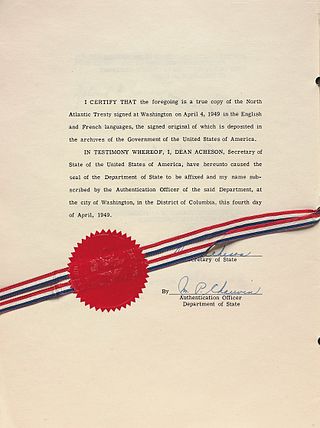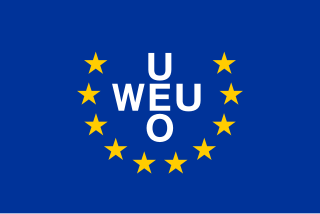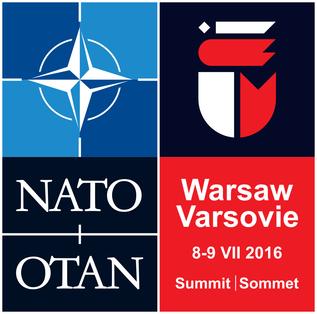Related Research Articles

The European Council is where EU leaders meet to set EU's political agenda, but they do not pass laws.

The North Atlantic Treaty Organization, also called the North Atlantic Alliance, is an intergovernmental military alliance of 31 member states – 29 European and two North American. Established in the aftermath of World War II, the organization implemented the North Atlantic Treaty, signed in Washington, D.C., on 4 April 1949. NATO is a collective security system: its independent member states agree to defend each other against attacks by third parties. During the Cold War, NATO operated as a check on the threat posed by the Soviet Union. The alliance remained in place after the dissolution of the Soviet Union and the Warsaw Pact and has been involved in military operations in the Balkans, the Middle East, South Asia, and Africa. The organization's motto is animus in consulendo liber.

The North Atlantic Treaty is the treaty that forms the legal basis of, and is implemented by, the North Atlantic Treaty Organization (NATO). The treaty was signed in Washington, D.C., on 4 April 1949.

The Western European Union was the international organisation and military alliance that succeeded the Western Union (WU) after the 1954 amendment of the 1948 Treaty of Brussels. The WEU implemented the Modified Brussels Treaty. During the Cold War, the Western Bloc included the WEU member-states, plus the United States and Canada, as part of the North Atlantic Treaty Organization (NATO).

The NATO Parliamentary Assembly serves as the consultative interparliamentary organisation for the North Atlantic Treaty Organization. Its current President is Michał Szczerba from Poland, elected in 2023. Its current Secretary General is Ruxandra Popa, who has been in this position since January 2020.

The 2004 Istanbul summit was held in Istanbul, Turkey from 28 to 29 June 2004. It was the 17th NATO summit in which NATO's Heads of State and Governments met to make formal decisions about security topics. In general, the summit is seen as a continuation of the transformation process that began in the 2002 Prague summit, which hoped to create a shift from a Cold War alliance against Soviet aggression to a 21st-century coalition against new and out-of-area security threats. The summit consisted of four meetings.

Relations between the NATO military alliance and the Russian Federation were established in 1991 within the framework of the North Atlantic Cooperation Council. In 1994, Russia joined the Partnership for Peace program, and on 27 May 1997, the NATO–Russia Founding Act (NRFA) was signed at the 1997 Paris NATO Summit in France, enabling the creation of the NATO–Russia Permanent Joint Council (NRPJC). Through the early part of 2010s NATO and Russia signed several additional agreements on cooperation. The NRPJC was replaced in 2002 by the NATO–Russia Council (NRC), which was established in an effort to partner on security issues and joint projects together.
The 1957 Paris summit was the first NATO summit bringing the leaders of member nations together at the same time. The formal sessions and informal meetings in Paris, France took place on 16–19 December 1957. This was only the second meeting of the NATO heads of state following the ceremonial signing of the North Atlantic Treaty on 4 April 1949.
The 1975 Brussels summit was the third NATO summit bringing the leaders of member nations together at the same time. The formal sessions and informal meetings in Brussels, Belgium took place on 29–30 May 1975. This event was only the third meeting of the NATO heads of state following the ceremonial signing of the North Atlantic Treaty on 4 April 1949.
The 1985 Brussels summit was the 7th NATO summit bringing the leaders of member nations together at the same time. The formal sessions and informal meetings in Brussels, Belgium took place on 21 November 1985. This event was only the seventh meeting of the NATO heads of state following the ceremonial signing of the North Atlantic Treaty on 4 April 1949. Lord Carrington was Secretary General of NATO at the time, and he chaired the meeting.
The 1988 Brussels summit was the 8th NATO summit bringing the leaders of member nations together at the same time. The formal sessions and informal meetings in Brussels, Belgium took place on 2–3 March 1988.
The 1994 Brussels summit was the 13th NATO summit bringing the leaders of member nations together at the same time. The formal sessions and informal meetings in Brussels, Belgium took place on 10–11 January 1994.
The 1977 London summit was the 4th NATO summit bringing the leaders of member nations together at the same time. The formal sessions and informal meetings in London took place on 10–11 May 1977. This event was only the fifth meeting of the NATO heads of state following the ceremonial signing of the North Atlantic Treaty on 4 April 1949.
The 1978 Washington summit was the 5th NATO summit bringing the leaders of member nations together at the same time. The formal sessions and informal meetings in Washington, D.C. took place on May 30–31, 1978. This event was only the fifth meeting of the NATO heads of state following the ceremonial signing of the North Atlantic Treaty on April 4, 1949.
The 1982 Bonn summit was the 6th NATO summit bringing the leaders of member nations together at the same time. The formal sessions and informal meetings in Bonn took place on 10 June 1982. This event was only the fifth meeting of the NATO heads of state following the ceremonial signing of the North Atlantic Treaty on 4 April 1949. When the summit was held, there were sixteen members of NATO.
The 1990 London summit was the 10th NATO summit since 1949. The ones before had been in November 1985, March 1988 and May 1989.

The 2016 Warsaw Summit of the North Atlantic Treaty Organization (NATO) was the 27th formal meeting of the heads of state and heads of government of the North Atlantic Treaty Organization, held at the National Stadium in Warsaw, Poland, on 8 and 9 July 2016.

The relationship between Azerbaijan and NATO started in 1992 when Azerbaijan joined the newly created North Atlantic Cooperation Council. Considerable partnership between NATO and Azerbaijan dates back to 1994, when the latter joined Partnership for Peace program. Azerbaijan established a diplomatic Mission to NATO in 1997 by the Presidential Decree on 21 November.

The 2018 Brussels Summit of the North Atlantic Treaty Organization (NATO) was the 29th formal meeting of the heads of state and heads of government of the North Atlantic Treaty Organization, held in Brussels, Belgium, on 11 and 12 July 2018.

The history of the North Atlantic Treaty Organization (NATO) begins in the immediate aftermath of World War II when British diplomacy set the stage to contain the Soviet Union and to stop the expansion of Soviet power in Europe. The United Kingdom and France signed, in 1947, the Treaty of Dunkirk, a defensive pact, which was expanded in 1948 with the Treaty of Brussels to add the three Benelux countries and committed them to collective defense against an armed attack for fifty years. The British worked with Washington to expand the alliance into NATO in 1949, adding the United States and Canada as well as Italy, Portugal, Norway, Denmark, and Iceland. Greece and Turkey joined in 1952, West Germany joined in 1955, Spain joined in 1982, Czech Republic, Hungary and Poland joined in 1999, Bulgaria, Estonia, Latvia, Lithuania, Romania, Slovakia, and Slovenia joined in 2004, Albania and Croatia joined in 2009, Montenegro joined in 2017, North Macedonia joined in 2020, and Finland joined in 2023.
References
- Thomas, Ian Q.R. (1997). The promise of alliance: NATO and the political imagination. Lanham: Rowman & Littlefield. ISBN 978-0-8476-8581-3; OCLC 36746439